 Image search results - "Afuri" Image search results - "Afuri" |
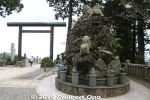
Torii at the top of the steps and Oyama mountain of lions.
|
|
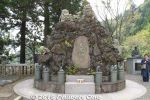
Oyama mountain of lions surrounded by animals from the Oriental zodiac. This is actually a large rock brought here from Mt. Fuji. Mt. Oyama's deity is the father of Mt. Fuji's goddess. 獅子山
|
|
|
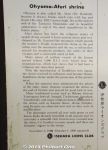
About Afuri Shrine.
|
|
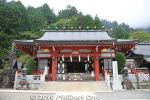
Oyama Afuri Shrine (大山阿夫利神社) Haiden prayer hall. The shrine was built to bring rain for agriculture. One of the gods enshrined is the father of Mt. Fuji's goddess. 拝殿
|
|
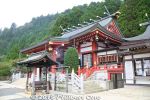
Haiden prayer hall. On the right of the Haiden, you can see the entrance to the basement where there is natural spring. 拝殿
|
|
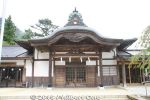
Kyakuden waiting room for worshippers. 客殿
|
|
|
|
|
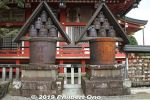
Huge monument that everyone stares at and wonder what it is. This sculpture of steel water buckets seems to be related to fire prevention, donated by people from Kawagoe, Saitama. 武蔵 川越
|
|
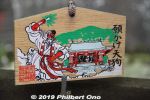
Ema tablet with a tengu goblin and Haiden Hall.
|
|
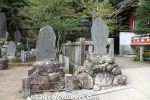
Lots of monuments at Oyama Afuri Shrine.
|
|
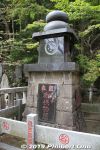
Monument from a pilgrimage group from Yanaka.
|
|
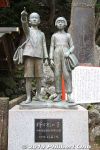
Children's monument from the city of Kawasaki.
|
|
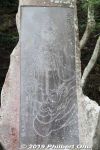
O-tengu goblin monument. 大天狗
|
|

Entrance to the hiking path to the Honsha main shrine on Mt. Oyama's summit. Takes about 2 hours to reach the summit. Steep and rocky trail. 登拝門
|
|

Steps to the Honsha main shrine on the mountaintop. From here, it's about a 90-min. hike to the Honsha main shrine on the summit.
|
|
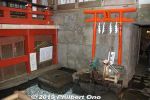
In the shrine's Haiden basement passage, Oyama meisui sacred water from a natural spring in the shrine's basement. You can fill your water bottle with this drinkable water. 大山名水
|
|
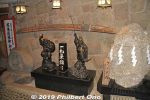
Religious sculptures, monuments, and a wooden sword offering displayed in the shrine's Haiden basement passage. 一礼来福
|
|
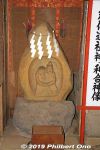
ぼけ封じ守護神
|
|
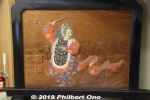
In the shrine's Kyakuden lobby, a screen partition depicting the Ranryo-o court dance. 蘭陵王
|
|
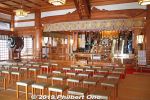
Inside Oyama Afuri Shrine (大山阿夫利神社).
|
|
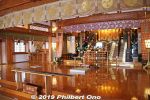
Oyama Afuri Shrine altar (大山阿夫利神社).
|
|
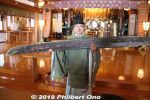
Oyama Afuri Shrine priest Kunihiko Meguro showed us a large wooden sword that was offered to the shrine by a pilgrimage group in 1905. (大山阿夫利神社).The tradition of bringing and offering a sword by pilgrimage groups started with Kamakura-based Shogun Minamoto no Yoritomo (1147–1199) who offered a sword to the shrine to pray for the defeat of his enemy, the Taira Clan. The offered swords got as big as 6 meters long made of wood.
|
|
|
|
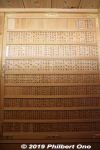
Names of shrine supporters.
|
|
|
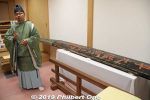
Oyama Afuri Shrine priest Kunihiko Meguro showed us a large wooden sword that was offered by a pilgrimage group.
|
|
|
|
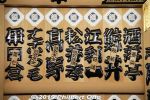
Names of worshippers who had tattoos. Their names also have labels describing their tattoos for ID purposes.
|
|
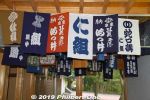
Nuno-maneki banners.
|
|
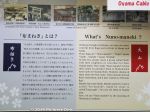
About Nuno-maneki banners.
|
|
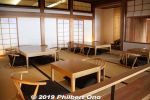
Afuri Shrine's cafe named Sekison, the indoor dining room. Open 9:30 am–4 pm. 石尊
|
|
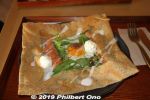
Galette for lunch. (ガレット)
|
|
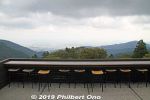
Afuri Shrine's Sekison cafe also has this outdoor counter with a view. On clear days, Enoshima and the ocean can be seen. 石尊
|
|
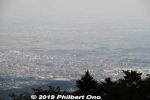
Hazy when we were there, but Enoshima island would be visible on clear days.
|
|
|
|
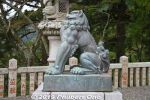
Lion statue at the shrine entrance.
|
|
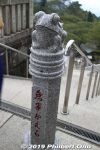
Frog for a safe return. "Kaeru"
|
|
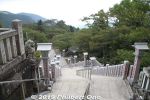
Steps back down. Mt. Oyama has Oyama-dera and a few other notable spots, but we didn't have time to visit them this day.
|
|
|
|